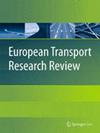Sustainable mobility in smart cities: a document study of mobility initiatives of mid-sized Nordic smart cities
IF 4.2
3区 工程技术
引用次数: 0
Abstract
Abstract The smart city concept is being viewed as part of the urban future, integrating technological advances, multi-sectorial collaboration, and innovative open markets with strategic goals and ambitions to achieve sustainable urban development. Smart mobility is considered a vital element of the smart city, given that urban transport systems should become more efficient and sustainable. With this in mind, we raise the question: how sustainable is smart mobility? To answer this, we review smart city strategies and measures of fourteen mid-sized cities of the Nordic Smart Cities Network, identifying smart mobility goals together with proposed or implemented mobility measures. We evaluate how they align with sustainable mobility and how effective they are with the help of two analytical frameworks: a) the EU’s Sustainable Urban Mobility Planning (SUMP) objectives and b) the S.M.A.R.T. objectives. In doing so, we assess to which degree smart mobility strategies and measures in Nordic smart cities contribute to sustainable urban mobility and development, and how they contribute to achieving sustainable and smart city goals in terms of feasibility and accountability. The study reveals that measures mainly address the SUMP objectives relating to efficiency and environment, with little focus on inclusive and safe mobility planning that caters to attractive cities and high quality of urban life. Another finding is that smart mobility measures are relatively conventional, and their goals and ambitions are often stated on an abstract level and rarely measurable with specific indicators. Thus, there seems to be a lack of feasibility and accountability related to smart mobility measures, as well as a lack of focus on social sustainability.智慧城市的可持续移动性:北欧中型智慧城市移动性倡议的文件研究
智慧城市概念被视为城市未来的一部分,它将技术进步、多部门合作和创新开放市场与实现可持续城市发展的战略目标和雄心相结合。智能交通被认为是智慧城市的重要组成部分,因为城市交通系统应该变得更加高效和可持续。考虑到这一点,我们提出了一个问题:智能交通的可持续性如何?为了回答这个问题,我们回顾了北欧智慧城市网络中14个中型城市的智慧城市战略和措施,确定了智能移动目标以及拟议或实施的移动措施。我们在两个分析框架的帮助下评估它们如何与可持续交通保持一致,以及它们的有效性:a)欧盟的可持续城市交通规划(SUMP)目标和b) S.M.A.R.T.目标。在此过程中,我们评估了北欧智慧城市的智能交通战略和措施对可持续城市交通和发展的贡献程度,以及它们如何在可行性和问责制方面为实现可持续和智能城市目标做出贡献。研究表明,这些措施主要是为了解决与效率和环境相关的SUMP目标,很少关注包容性和安全的交通规划,以迎合有吸引力的城市和高质量的城市生活。另一个发现是,智能移动出行措施相对传统,它们的目标和抱负往往是在抽象层面上陈述的,很少有具体指标可以衡量。因此,似乎缺乏与智能交通措施相关的可行性和问责制,也缺乏对社会可持续性的关注。
本文章由计算机程序翻译,如有差异,请以英文原文为准。
求助全文
约1分钟内获得全文
求助全文
来源期刊

European Transport Research Review
Engineering-Mechanical Engineering
CiteScore
9.70
自引率
4.70%
发文量
49
期刊介绍:
European Transport Research Review (ETRR) is a peer-reviewed open access journal publishing original high-quality scholarly research and developments in areas related to transportation science, technologies, policy and practice. Established in 2008 by the European Conference of Transport Research Institutes (ECTRI), the Journal provides researchers and practitioners around the world with an authoritative forum for the dissemination and critical discussion of new ideas and methodologies that originate in, or are of special interest to, the European transport research community. The journal is unique in its field, as it covers all modes of transport and addresses both the engineering and the social science perspective, offering a truly multidisciplinary platform for researchers, practitioners, engineers and policymakers. ETRR is aimed at a readership including researchers, practitioners in the design and operation of transportation systems, and policymakers at the international, national, regional and local levels.
 求助内容:
求助内容: 应助结果提醒方式:
应助结果提醒方式:


